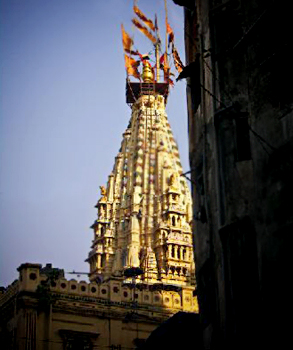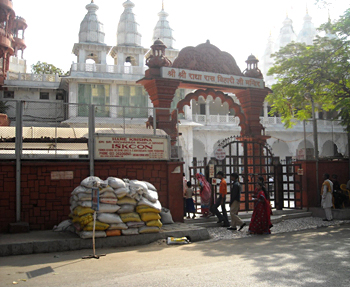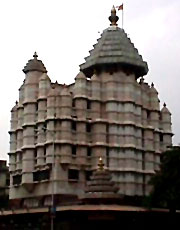 Temples in Mumbai are the major attractions for the tourists as well as the devotees from all corners of India. The city of Mumbai was previously known as a place where a several Gods and Goddesses of the Hindu religion are worshipped. Huge gathering of devotees at the temple premises, chanting of the sacred scripts of the Hindu faith is a sight to be witnessed. Although these temples in the capital city of Maharashtra receive devotees throughout the year, but it is Ganesh Chaturthi that is hailed as a major festival here. Celebrated over a period of 10 days, both devotees and tourists flock the temples in Mumbai to participate in this festival.
Temples in Mumbai are the major attractions for the tourists as well as the devotees from all corners of India. The city of Mumbai was previously known as a place where a several Gods and Goddesses of the Hindu religion are worshipped. Huge gathering of devotees at the temple premises, chanting of the sacred scripts of the Hindu faith is a sight to be witnessed. Although these temples in the capital city of Maharashtra receive devotees throughout the year, but it is Ganesh Chaturthi that is hailed as a major festival here. Celebrated over a period of 10 days, both devotees and tourists flock the temples in Mumbai to participate in this festival.
One of the prominent Hindu temples in Mumbai is the Mumba Devi temple. The city of Mumbai got its name from this temple. Mumbadevi is regarded as the patron goddess of the city of Mumbai. This sacred Hindu temple in Mumbai is considered to be one of the major Shakti temples in Mumbai it is famous all over Mumbai and other parts of Maharashtra as a sacred place of worship. The importance of this temple in Mumbai is also because of the fact that the present name of the city has been given after the Main deity of the temple, Mumbadevi. Previously, the Mumbadevi temple stood at a place which is presently called the Victoria Terminus in Mumbai central. The temple was constructed in the honour of the Goddess Mumbadevi. Mumbadevi is also regarded as the major deity of the Koli fishermen. These people are the original denizens of the city of Mumbai. In the year 1737, the first Mumbadevi temple was constructed at Bori Bunder. Later, the temple was dismantled and rebuilt where it is presently, at Bhuleshwar.
In the beginning, the Mumbadevi temple in Mumbai was not as beautiful and attractive as other Mumbai temples. However, the reverence and faith of the people of Mumbai over the Goddess Mumbadevi gives the temple of Mumbadevi an inherent beauty. As per the Hindu mythology, this temple of Mumbai, dazzling with spiritual beauty was a result of the handiwork of Mumbarka. Mumbarka was known as a vicious giant. He was interested in plundering the city of Mumbai in his leisure hours. The people of the city of Mumbai appealed before the Lord Brahma the problem they used to face because of Mumbarka. Lord Brahma was regarded as the creator of the Universe. It is believed that, as a result of the prayers of the people, Lord Brahma conjured a Goddess having eight arms who crushed the demon for good reasons. Thus, defeated at the hands of the Goddess, Mumbarka prayed before her to have his name and afterwards constructed a temple in the honour of the Goddess. The goddess still stands there over an altar sprinkled with marigolds, having an orange coloured face. Common belief is that, those who take the blessings of this goddess they are never disappointed in life. The modern shrine at Mumbai possesses an idol of the goddess Mumbadevi. She is seen wearing a robe and a silver crown, a golden necklace and a nose stud. To the left of the Goddess Mumbadevi is the statue of Annapurna who is shown sitting on a peacock. Tiger is considered to be the carrier of the goddess and its statue is in front of the temple. The peculiarity of the goddess Mumbadevi is that she does not have a mouth and thus it is symbolic of the Mother Earth. There are various other shrines inside the Mumbadevi temple complex and those are dedicated to the lord Maruit, Ganesh, Mahadev, Murlidhar, Indrayani, Jagannath, Balaji and Narsoba.
 Another major temple in Mumbai is the Hare Rama Hare Krishna temple or ISKCON temple located at Juhu in the city of Mumbai. This is one of the most-visited temples dedicated to Lord Radha Rasabihari or Lord Krishna in Mumbai. This temple is handled by ISKCON. It is constructed on the prime land of Hare Krishna Land which spreads over an area of four acres. This temple of Lord Krishna is a tribute to the perseverance and genius of Srila Parabhupada which has helped in spreading the Krishna consciousness. Countless numbers of devotees visit this temple from all corners of the world. The ISKCON temple in Mumbai is opened for the devotees in the year 1978 in the form of a spiritual oasis. The place is no less similar to that of the atmosphere of heaven and people get peace in its peaceful and calm environment. People here are engaged in deep meditation and also take part in the hypnotic chanting of mantras which in turn detoxifies the spiritual health and helps in the enlightenment of the soul. All sorts of facilities are available inside this temple to give the place a spiritual atmosphere. There is a spacious marble temple inside the temple complex, a book-publishing house, a top-end auditorium and a restaurant. There is also a twin-towered guest house of six stories which is for the accommodation of the visitors. The absolute presence of devotees assembling in the ISKCON temple gives a spiritual pleasure to those who are in search of it. Daily, five thousand or more pilgrims move into this temple and on every Sunday the number goes beyond ten thousand. The most-renowned celebration at this temple is Janmashtami, which is celebrated with mush pump and glory in the month of August and September. In this auspicious occasion, this temple at Juhu is crowded with millions of devotees from various parts. The city of Mumbai is regarded as the international gateway and a number of flight operators connect Mumbai with several prominent locations in the world. It is very convenient to reach the ISKCON temple and people can avail anything from a rickshaw, taxi, cycle, bus, bullock cart, etc.
Another major temple in Mumbai is the Hare Rama Hare Krishna temple or ISKCON temple located at Juhu in the city of Mumbai. This is one of the most-visited temples dedicated to Lord Radha Rasabihari or Lord Krishna in Mumbai. This temple is handled by ISKCON. It is constructed on the prime land of Hare Krishna Land which spreads over an area of four acres. This temple of Lord Krishna is a tribute to the perseverance and genius of Srila Parabhupada which has helped in spreading the Krishna consciousness. Countless numbers of devotees visit this temple from all corners of the world. The ISKCON temple in Mumbai is opened for the devotees in the year 1978 in the form of a spiritual oasis. The place is no less similar to that of the atmosphere of heaven and people get peace in its peaceful and calm environment. People here are engaged in deep meditation and also take part in the hypnotic chanting of mantras which in turn detoxifies the spiritual health and helps in the enlightenment of the soul. All sorts of facilities are available inside this temple to give the place a spiritual atmosphere. There is a spacious marble temple inside the temple complex, a book-publishing house, a top-end auditorium and a restaurant. There is also a twin-towered guest house of six stories which is for the accommodation of the visitors. The absolute presence of devotees assembling in the ISKCON temple gives a spiritual pleasure to those who are in search of it. Daily, five thousand or more pilgrims move into this temple and on every Sunday the number goes beyond ten thousand. The most-renowned celebration at this temple is Janmashtami, which is celebrated with mush pump and glory in the month of August and September. In this auspicious occasion, this temple at Juhu is crowded with millions of devotees from various parts. The city of Mumbai is regarded as the international gateway and a number of flight operators connect Mumbai with several prominent locations in the world. It is very convenient to reach the ISKCON temple and people can avail anything from a rickshaw, taxi, cycle, bus, bullock cart, etc.
Walkeshwar temple is another major temple in Mumbai. This is one of the most ancient temples of the city which has also earned a name for itself in the list of heritage sites because of its architectural design and its popularity within the pilgrims. This temple was initially constructed by the Silharas probably 1050 years ago on the Malabar Hill. It has got its name from Valuka Ishwar, which means, Lord of Sand. The Walkeshwar temple was demolished by the Portuguese in the 16th century and the same was reconstructed by Rama Kamath in the year 1715. However, the present form of this temple in Mumbai has been ready in the 1950`s. According to the legend, this temple in Mumbai was founded at the same place where Lord Rama of the Hindu epic, Ramayana, halted for a short while he was raiding the kingdom of Ravana, the demon king, who had abducted his wife Sita. At this place, Lord Rama had erected a lingam (Phallus, representation of Lord Shiva) with sand, since his younger brother Lakshmana was very late to carry a lingam for puja. The name of Walkeshwar was thus an inspiration of this legendary incident. It is also believed that at this place the Lord Ram got thirsty and without getting any means to quench it, he shot an arrow which resulted in the formation of a sweet jet of water and it is said to be the major source of the Banganga tank which is there at present. As per history, in the year 1127 A.D., Lakshman Prabhu constructed the Banganga tank. Lakshman Prabhu, at that time, was a minister in the court of Silhara dynasty kings who reined the Thane region from 810 to 1240 AD. The renowned seat of Saraswat Brahmins which is also a branch of the Shri Kashi Mutt is situated on the Banganga tank"s western bank. Tourists in large numbers visit the Walkeshwar temple on Amavasya and the Full Moon nights. Currently, the site of Banganga tank in Walukeshwar temple is very precious with the staging of an annual classical Hindustani music festival. The importance of this festival is due to the participation of amateur singers and the presence of maestros in a large scale. Maharashtra Tourism Development Corporation (MTDC) organizes the annual Hindustani classical music festival in the earlier parts of the month of January. The live music performance and concerts at this festival bring together a vibrant musical atmosphere.
 Lord Ganesha is the most-revered Hindu Gods in the state of Maharashtra who is worshipped widely in the state. The Shree Siddhivinayak Ganapati Mandir situated in Prabhadevi in the city of Mumbai is among the most popular temples in the city visited by a large number of devotees throughout the year. This temple was earlier founded by Deubai Patil and Laxman Vithu and in the year 1801. The Siddhivinayak temple in Mumbai is having a small mandapam or a hall with Siddhivinayak"s shrine. With marvelous architectural design, this temple in Mumbai dedicated to the Lord Ganesh possesses wooden doors to the sanctum, in which the images of Asthavinayak or the eight forms of Lord Ganesh in Maharashtra, is carved. The inner roof of the sanctum of this temple is plated with gold and the central statue of Ganesh is displayed having four arms, bearing an axe, a lotus, modakas and a garland of beads. The image of Lord Ganesh is placed in between his two wives, Riddhi and Siddhi. The most auspicious day to visit the Shree Siddhivinayak Ganapati Mandir is on Tuesday. On this day, a large number of devotees visit this temple to offer prayers and get the blessings of Lord Ganesha. As per Hindu religion, Lord Ganesh is considered most august and any new work begins after his prayer. This temple in Mumbai is also famous for its V.I.P. devotees who visit this temple regularly and therefore the security arrangements at the temple premises and its locality is very tight. This Hindu temple in Maharashtra possesses a very narrow lane outside its area which is known as the Phool galli, which is lined with a variety of stalls. These stalls sell several items of worship like coconuts, tulsi flower garlands sweets including the rotund much loved yellow coloured sweet of Lord Ganesha, called modak. Devotees can also search for several religious equipments at these stalls. Similar to other major places of worship in the Indian sub-continent, the temple in the city of Mumbai is also filled with beggars and one in no way can escape from the eyes of these people who expect something or the other from the devotees. The upper floors of the temple are for the priest"s resident.
Lord Ganesha is the most-revered Hindu Gods in the state of Maharashtra who is worshipped widely in the state. The Shree Siddhivinayak Ganapati Mandir situated in Prabhadevi in the city of Mumbai is among the most popular temples in the city visited by a large number of devotees throughout the year. This temple was earlier founded by Deubai Patil and Laxman Vithu and in the year 1801. The Siddhivinayak temple in Mumbai is having a small mandapam or a hall with Siddhivinayak"s shrine. With marvelous architectural design, this temple in Mumbai dedicated to the Lord Ganesh possesses wooden doors to the sanctum, in which the images of Asthavinayak or the eight forms of Lord Ganesh in Maharashtra, is carved. The inner roof of the sanctum of this temple is plated with gold and the central statue of Ganesh is displayed having four arms, bearing an axe, a lotus, modakas and a garland of beads. The image of Lord Ganesh is placed in between his two wives, Riddhi and Siddhi. The most auspicious day to visit the Shree Siddhivinayak Ganapati Mandir is on Tuesday. On this day, a large number of devotees visit this temple to offer prayers and get the blessings of Lord Ganesha. As per Hindu religion, Lord Ganesh is considered most august and any new work begins after his prayer. This temple in Mumbai is also famous for its V.I.P. devotees who visit this temple regularly and therefore the security arrangements at the temple premises and its locality is very tight. This Hindu temple in Maharashtra possesses a very narrow lane outside its area which is known as the Phool galli, which is lined with a variety of stalls. These stalls sell several items of worship like coconuts, tulsi flower garlands sweets including the rotund much loved yellow coloured sweet of Lord Ganesha, called modak. Devotees can also search for several religious equipments at these stalls. Similar to other major places of worship in the Indian sub-continent, the temple in the city of Mumbai is also filled with beggars and one in no way can escape from the eyes of these people who expect something or the other from the devotees. The upper floors of the temple are for the priest"s resident.
Apart from Hindu temples, temples of other faith are also present in the capital city of the state of Maharashtra. The Babu Amichand Panalal Adishwarji Jain temple in Mumbai is one of the prettiest temples in the city. However, Jain temples in general are very beautiful in India. Members of the Jain community are peace loving and they practice severe pain to avoid killing even a very small insect. The Jains are well known in the world of business are known to be exceptional in the world of business. They believe in ultimate self-control and aestheticism. These people however donate heavily for the proper maintenance and construction of their temples. The elegantly designed and very attractive Babu Amichand Panalal Adishwarji Jain temple in Mumbai is having an entrance lined by two elephants made of stone. The downward area holds a range of deities and saints, which also includes an image of Lord Ganesha. The presence of the image of Lord Ganesh reminds one of the historical links in between Hinduism and Jainism. There are also three black idols which are preserved cautiously behind a metal screen. The dome-shaped ceiling of this Mumbai Jain temple is painted with zodiac symbols.
One of the prominent Buddhist temples in Mumbai is the Nipponzan Myohoji temple. This temple is also the oldest Buddhist temple of the city. The Nipponzan Myohoji temple attracts a large number of devotees throughout the year. The peaceful and calm atmosphere at this temple complex is also one of the major factors of its popularity.
Mumbai, the capital city of Maharashtra, possesses a number of temples which attract a large number of devotees from Mumbai and various other parts of India. Some of the temples in Mumbai which witness the influx of huge devotees all the time are Mahalaxmi temple, Babulnath Temple, Ayyappa Temple, Balaji Temple at Nerul, Bell temple, Sion Vitthal Mandir, Banganga temple, etc.





















